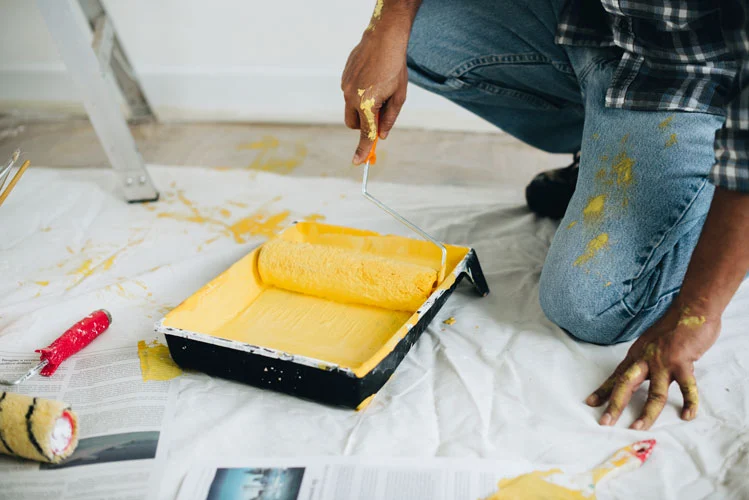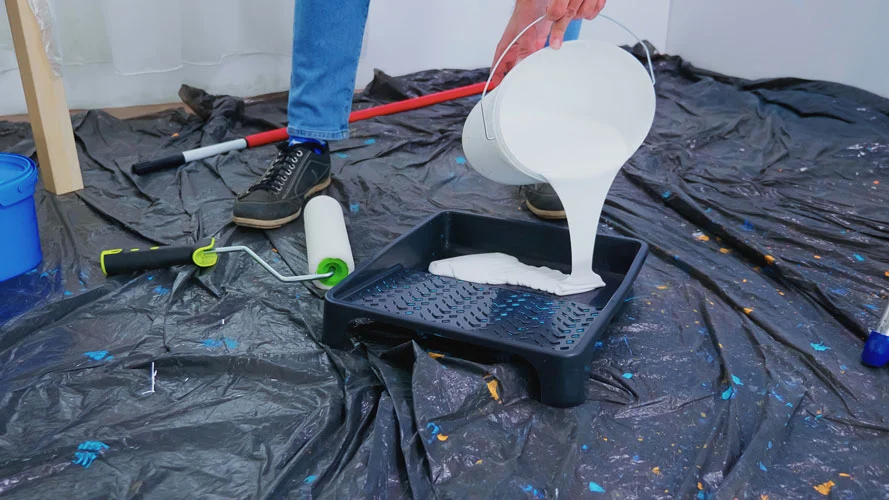Mineral Spirits vs. Paint Thinner
Even though the market has moved to latex paints, many professionals use oil-based paint for its versatility. They have the ability to self-level and also go streak-free. However, the only disadvantage is that they require a solvent and not water.

Mineral spirits and paint thinner are the principal solvents used to thin oil paint. Both are made of petroleum goods and work similarly. However, both the solvents have some key differences and similarities too. You can use both the solvents to thin paint and also work as paint removers.
The article points out the similarities and differences between the two substances. This will help you make an informed decision about whether to use mineral spirits or paint thinner for your project.
Are Mineral Spirits the Same as Paint Thinner?
No! While the two chemicals are similar, they have different chemical compositions. And hence they are two different products.
Paint thinner is a mineral spirit in a simple form without any additives. Both are similar in composition in that they are interchangeable in many aspects. They also work similarly. A paint thinner is a more generic term that defines the purpose of the product.
Mineral Spirits vs. Paint Thinner – 4 Key Differences

Paint thinner is a common phrase for solvents used when thinning paint. Or removing paint from brushes. Examples of paint thinners consist of acetone, turpentine, toluène, and mineral spirits. The word paint thinner describes the solvents as above, and not only mineral spirits. Mineral spirits are different from most of the other paint thinners in terms of toxicity. Mineral spirits may be less toxic and also easier to deal with.
Both the chemicals are the result of the distillation of petroleum. You can even use them for the same purposes. However, mineral spirits are heavily refined, contain fewer VOCs, and have pungent odors. They also retain the oiliness of petroleum, which gives them a lubricating quality.
Here are some of the key differences between the two similar chemicals.
Toxicity
Toxicity is one of the important differences between the two solvents. Mineral spirits are refined to a great degree than paint thinner. But, in the case of paint thinners, they remain most of their toxic compounds like benzene and toluene. They are also not safe around pets and children due to their toxicity.
Effectiveness
Another main difference is the effectiveness of the two substances. You can use mineral spirits for cleaning surfaces as well as solvent use. This is due to its refinement process, which removes the toxic VOCs and sulfur. Several professional painters and artists prefer mineral spirits to clean their painting utensil. Compared to paint thinners, mineral spirits works better when it comes to thinning oil-based paints. This is due to its slow evaporator factor. Paints thinned with mineral spirits have a smooth finish than with paint thinners. This is because the latter evaporates faster.
Odor
Mineral spirits and paint thinners emit an almost kerosene-like odor. This is due to the presence of VOCs. The lower the VOC, the less obnoxious they are.
Paint thinners are pretty toxic, and their fumes are harmful. And as such, anyone working with them should avoid inhaling too much of it. On the other hand, mineral spirits have a very low odor compared to paint thinner.
For a safer operation, it is advisable to store these solvents at room temperature in well-ventilated areas. That way, you can avoid the potential adverse consequences of toxic fumes.
Price
Paint thinner is about half as expensive as mineral spirits. For example, a gallon of mineral spirits costs $10. And odor-free mineral spirits will cost you $15. On the other hand, paint thinners cost you only $8 per gallon.
Mineral spirits are distilled to remove most of the toxicity. This accounts for the increase in cost. The processing for obtaining mineral spirits is quite demanding compared with paint thinners. The less demanding process of manufacturing paint thinners results in an unrefined solvent at a much lesser cost. However, the cost shouldn’t affect you much.
Thinning paint or cleaning brushes should cost you more than a few ounces. Unless you are buying in bulk, the difference in cost may not matter. However, if the quality of air is a priority, mineral spirits are the one for you.
What is a Paint Thinner?
Paint thinners are solvents that are used for removing and thinning oil-based paint. They are made out of mineral spirits or by mixing in added additives. It is obtained via the distillation of petroleum and is less refined than mineral spirits. They also use less-expensive ingredients in the manufacturing process. Unfortunately, this means paint thinner also has harsh odors and requires you to wear a respirator mask for working with it. The odor makes it much less appealing, even though it is cheaper than mineral spirits.
Pros and Cons
- Paint thinner is cost-effective and is also a suitable cleaning agent.
- The strong chemicals present in the solvent emit a pungent odor. It is also quite harsh on the skin.
Different Uses of Paint Thinner
As the name indicates, professionals use paint thinners to thin oil-based paints. Oil-based paints require a special solvent to thin them out when used in a sprayer. Although, paint thinner will be more beneficial in other applications than painting. It can also clean drips, spills, and hard grease grime, as well as marks. You can also use it to clean your painting tools. You can also apply paint thinners to wood that requires a good clean after sanding.
Caution: Paint thinner is a harsh solvent and may damage some surfaces if applied too much.
Is There a Substitute for Paint Thinner?
Mineral spirits and acetone are acceptable substitutes for paint thinners. However, you should use proper ratios for them to work as paint thinner. For example, experts recommend a ratio of three parts paint to one part solvent.
These solvents can emit harsh fumes when used to thin paints. Hence, you need to follow a few safety measures, including:
- Do not forget your mask, safety goggles, and rubber gloves.
- Change into old clothes to avoid discoloration.
- Finally, use the solvents in a well-ventilated area with good airflow.
What are Mineral Spirits?

Mineral spirits are organic solvents you use for cleaning equipment and thinning paints. Otherwise, called Stoddard solvent or white spirit, they are also used as a cleaning agent. They are made via the petroleum distilling process. Mineral spirits are also heavily refined when compared to paint thinner. The refinement process removes the VOCs and sulfur, thereby reducing the odor. Hence, they are good to use indoors and in confined areas.
Mineral spirits have a slower evaporation rate. Any paint thinned by using this product will achieve a smoother and more level coat upon drying. With all these benefits comes a higher price. But remember, you only need a small amount, so the price doesn’t matter.
Pros and Cons
- Mineral spirits are much versatile than paint thinners and, as such, have a wide range of uses.
- They are heavily refined and very low odor. Hence, they have lesser VOCs.
- They are easy to use and measure.
- The benefits come at a cost. Mineral spirits are much more expensive than paint thinners.
Different Uses of Mineral Spirits
Mineral spirits are often used to thin oil-based paint. It is also a lubricating agent, which may be helpful if applied to stains such as dust and mildew. This product is generally selected for use indoors since it has a faint odor compared to a paint thinner. You can use mineral spirits on all surfaces to remove difficult dirt and grime. You can also use mineral spirits to remove tar and oils from a variety of other surfaces.
What is a Good Substitute for Mineral Spirits?
Many counties have banned mineral spirits due to their toxic nature. Unfortunately, this means that do-it-yourselfers have to find alternatives for the same. Here are a few substitutes that work the same way.
- Acetone – It is a solvent and hence can be used for cleaning or degreasing. You can use it on plastic, glass, and metal.
- Denatured alcohol works best as a solvent for cleaning. But, you cannot use it to thin paints.
- Turpentine – Like mineral spirits, you can use it to clean brushes or thin paints.
- Charcoal Lighter Fluid – You can use it the same way since it is made of mineral spirits.
- Oil, soap, and water (only for cleaning)
Similarities Between Mineral Spirits and Paint Thinner
Keeping it short, both mineral spirits and paint thinners have similar compounds. Mineral spirits are a more refined version of thinners. Hence, both the solvents have quite similar uses, which include:
- Thinning oil-based paints
- Stripping adhesives
- Removing waxy films
- Cleaning paint brushes
- Degreasing
For all the uses mentioned above, both mineral spirits and paint thinners work well. However, paint thinners can be cost-effective.
Why is Mineral Spirits Better Than Paint Thinner?
Mineral spirits are generally more refined than paint thinner. Hence, they are effective even in small quantities. They are not as stinky and do not emit as many fumes as thinners do. Moreover, they have a slow rate of evaporation. Hence, paint thinned with mineral spirits tends to have a smooth finish compared to a paint thinner.
Which Solvent Dissolves Oil-Based Paints?
Both mineral spirits and paint thinners will dissolve oil-based paints. They are clean, clear, non-sticky solvents that work similarly. However, it should be wet paint and not dry or cured. If the paint is dry, you need to use acetone. Acetone is the only solvent that can dissolve dry oil paint.
Can You Use Mineral Spirits to Thin Paint?
Yes! You can use mineral spirits to thin paint, especially oil-based paint. Furthermore, it also works to thin or clean varnishes and stains.
When Should I Choose Between Paint Thinner and Mineral Spirits?
Both substances are very similar and are used for most of the same purposes. Understanding the differences between mineral spirits vs. paint thinner is essential. This is because many people don’t realize both have similar uses. Pure mineral spirits are expensive. Hence, it is important that you use it in small amounts. Since they have a low odor, they are ideal for indoor use. But, paint thinners are inexpensive. And hence are helpful for both commercial and large residential areas where the need is more.
Side Effects of Using Mineral Spirit and Paint Thinners
Mineral spirits and paint thinners constitute several chemicals, good and toxic. This means that no matter what, they will have side effects. While both solvents are helpful in many applications, you need to use caution.
- Inhaling the two solvents can result in nausea, dizziness, and difficulty breathing.
- When used in confined spaces, they can make you feel dizzy, and in the end, you may even faint.
- Should the solvents fall on your skin, they can cause rashes and, in worst cases, burns.
- They will burn your digestive tract should you ingest them. You may also get severe throat pains.
Here are a few safety tips you can follow to ensure caution.
- Always keep these solvents away from any heat source since they are highly flammable.
- Wear gloves whenever you are handling spirits. If they end up on your skin, wash it off at once.
- Avoid inhaling the solvents. Cover your nose and throat when working with them.
Are These Substances Toxic?
Both the chemicals are solvents and have harsh chemicals. They contain some level of toxicity. However, mineral spirits are more refined and have fewer odors. Since both the chemicals are used for cleaning oil-based paints, they contain some pretty strong and toxic substances. Hence, you must follow the safety rules.
Are Acetone and Mineral Spirits the Same?
Both acetone and mineral spirits are solvents used for various applications. For example, they clean up the messes that soap and water cannot clean. However, there are many key differences. Neither acetone nor mineral spirits are interchangeable. Depending on the job, you can use either mineral spirits or acetone.
Both the solvents are used to thin paints. However, mineral spirits thin oil paints, while acetone works as a lacquer thinner. Unlike mineral spirits, acetone is not water-soluble and has an offensive odor.
Conclusion

Paint thinner and mineral spirits have several significant differences which deserve mention. First, they both rely on the same petroleum distillates. However, paint thinners have additional chemical additives. Hence, they are at a lower price point than mineral spirits. They also have a strong odor that’s not ideal when working indoors. Mineral spirits are available, which you can often see in home improvement stores.
Both the solvents have their advantages and disadvantages. You should pick the one that works for your project. Refined mineral spirits are ideal for use indoors, although they are expensive. For all other projects where the smell is not a problem, experts recommend paint thinners.
If you are looking for a stress-free painting experience, you need to choose the right contractors – contact Nelson Greer Painting Contractors for your FREE quote today. We will make sure that your home is properly painted inside and out to last you for years to come. With over 220 years of experience in our company’s history, you’ll love what we can do with our professional painting contractors.
Categories
- Church Painting (1)
- Commercial Painting (14)
- Exterior Painting (6)
- Interior Painting (2)
- FAQ (1)
- Floor Coating & Sealing (3)
- General (13)
- Industrial Painting (1)
- Metal Painting (1)
- Paint Prep (3)
- Painting Contractors (4)
- Pool Deck Epoxy (1)
- Residential Painting (32)
- Baseboards & Trim (2)
- Cost (3)
- Exterior Painting (8)
- Interior Painting (7)
- Tips (2)
- Walls (6)
- Roof Replacement (1)